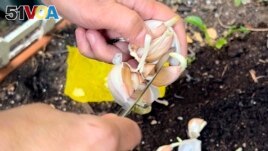16 October 2022
You might think most people like to plant cold-weather greens like kale, or Brussels sprouts. But Jessica Damiano learned from search data that the most popular fall-planted crop in the United States is ... garlic.
Damiano studied Google's search trends. She compared Americans' interest in growing garlic with their interest in planting flower bulbs. She was surprised to find that, when people used the search term "how to grow...," garlic was the most common word when compared with other spring bulb plants.
Damiano thinks that is the result of a lack of knowledge about growing garlic. People already know how to plant flower bulbs. Growing garlic is actually as easy as growing daffodils. Here is what you need to know before you plant it:

In this Oct. 16, 2021, image provided by Jessica Damiano, a garlic bulb is separated into cloves for planting. (Jessica Damiano via AP)
There are two varieties, or kinds, of garlic — hardnecks and softnecks. Plant the variety best for your climate.
Plant hardneck varieties in northern areas six to eight weeks before a hard frost. Their heads, or bulbs, have a single row of large cloves, or divisions, formed around an underground stem. They are tastier than softnecks but do not last as long in storage.
Softneck varieties are better for growing in warmer climates. Their heads contain several rows of smaller cloves. Since they last longer after harvest, softnecks are usually the kind shoppers find in supermarkets.
Plant only seed garlic from a dependable supplier – or cloves from the largest, healthiest heads saved from last year's harvest.
Garlic plants need a good amount of nutrition, so add some compost into the top eight to 11 centimeters of soil to make it richer. If you can get some mycorrhizae fungus, a garden additive, it will help the bulb form.
Do not plant the garlic you find in the supermarket. Growers may have sprayed a chemical on it to stop it from growing while at the store or in your home. It also may not be the kind best for your growing conditions.
Separate the head into individual cloves. Do not remove the outer layer, of papery skin. Plant the cloves with the pointy end up, about five centimeters deep and 15 centimeters apart in rows spaced 30 centimeters apart.
Cover with soil, press it down and water well.
If your winter temperature falls below four degrees Celsius, add a thick cover of straw as mulch to the garden bed. Water the straw to settle it into place.
It is fine for the garlic plants to send out green growth, or sprouts, during autumn and early winter, even in northern climates. Do not worry about possible damage to this growth in cold weather.
Remove the mulch in spring, after the danger of frost has passed. Put a little fertilizer between each row five to 10 centimeters from the stems. Keep the bed free of weeds.
Hardneck varieties will send up tall, leafless stems called scapes in late spring. Remove them so the plant gives all its energy to forming the bulb. The scapes are delicious and taste a little like garlic. You can put them in salads, soups or cooked with other vegetables.
Your garlic will be ready to harvest in mid-to-late summer when at least 50 percent of the plant has turned yellow. Carefully dig the bulbs out and brush off the soil. Do not wash them.
Set hardneck varieties with their stems attached on a drying surface, like a rack or screen, then place in a cool, dry spot for two weeks. You can wrap the stems of softneck varieties together and hang them to dry. The garlic's papery skin will help make it last longer.
Store bulbs in a cool, dry spot. Hardnecks will remain fresh for at least three to six months; softnecks will last up to nine months.
I'm Jill Robbins.
Jessica Damiano reported on this story for the Associated Press. Jill Robbins adapted it for Learning English.
_______________________________________________________________________
Words in This Story
bulb – n. a root shaped like an onion that grows into a flower or plant
trend –n. something that is currently popular, fashionable or of interest to people
bloom – n. the flower on a plant.
neck – n. the long narrow part at one end of an object, such as a flower or vegetable bulb
compost – n. a mixture of decayed plants and vegetable waste which is added to the soil to help plants grow.
frost – n. a temperature low enough to cause freezing
row –n. a line of things one after the other
clove – n. a section of a garlic bulb
stem – n. any stalk or part supporting leaves, flowers, or fruit
mulch – n. a layer of something such as old leaves, small pieces of wood, or manure which you put on the soil around plants to protect them and help them to grow.